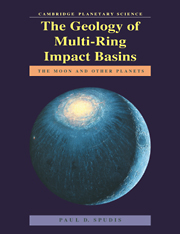Book contents
- Frontmatter
- Contents
- Preface
- 1 The multi-ring basin problem
- 2 From crater to basin
- 3 The ‘archetype’ basin: Orientale
- 4 An ancient basin: Nectaris
- 5 A modified basin: Crisium
- 6 A transitional basin: Serenitatis
- 7 The largest basin: Imbrium
- 8 Geological processes in the formation of lunar basins
- 9 Multi-ring basins on the terrestrial planets
- 10 Multi-ring basins and planetary evolution
- References
- Index
3 - The ‘archetype’ basin: Orientale
Published online by Cambridge University Press: 12 October 2009
- Frontmatter
- Contents
- Preface
- 1 The multi-ring basin problem
- 2 From crater to basin
- 3 The ‘archetype’ basin: Orientale
- 4 An ancient basin: Nectaris
- 5 A modified basin: Crisium
- 6 A transitional basin: Serenitatis
- 7 The largest basin: Imbrium
- 8 Geological processes in the formation of lunar basins
- 9 Multi-ring basins on the terrestrial planets
- 10 Multi-ring basins and planetary evolution
- References
- Index
Summary
The Orientale basin (Figure 3.1) is located on the western limb of the Moon; most of the basin and its deposits extend over the lunar far side. The name “Orientale” (eastern) is derived from the old astronomical practice of displaying telescopic photographs of the Moon with south at the top and east-west convention derived from terrestrial coordinates. The first studies of the Orientale basin utilized Earth-based telescopic photographs; because of the basin's location on the extreme limb, these photographs were geometrically rectified at the Lunar and Planetary Laboratory (University of Arizona) to create a vertical viewing perspective (Hartmann and Kuiper, 1962). These rectified photographs also served as the primary data base for an early geological study of Orientale as the prototype lunar basin (McCauley, 1968).
Because of the spectacular success of the Lunar Orbiter spacecraft, particularly a series of high-quality photographs by Orbiter IV that provide contiguous coverage, the number of detailed geological descriptions of the Orientale basin increased dramatically in the years immediately following the Apollo missions (Hartmann and Wood, 1971; Head, 1974a; Moore et al., 1974; McCauley, 1977; Scott et al., 1977; Spudis et al., 1984b). In this chapter, I review the regional and local geology of Orientale and, in conjunction with data from photogeology and remote sensing, integrate these data into a geological model for the formation and evolution of the basin.
Regional geology of the Orientale impact site
The Orientale basin is sparsely filled by mare basalt and located in rugged highland terrain on the western limb of the Moon (Figure 3.1).
- Type
- Chapter
- Information
- The Geology of Multi-Ring Impact BasinsThe Moon and Other Planets, pp. 42 - 66Publisher: Cambridge University PressPrint publication year: 1993



